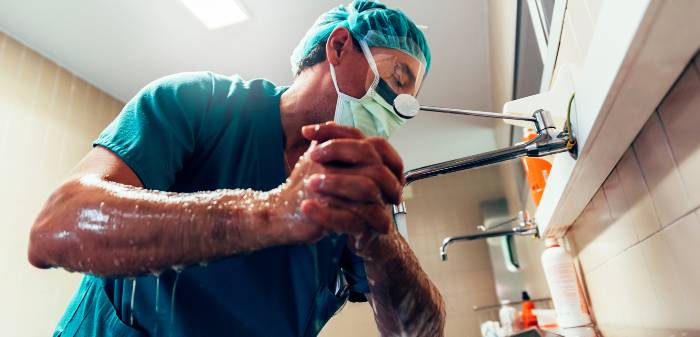Web-Based Hand Hygiene Application Improves HCW Compliance
Swiss hospital developed and implemented “Clean Hands,” and the results are significant over paper data collection.
Physician washing hands and arms (Adobe Stock)

Hand hygiene (HH) is the first and simplest defense against HAIs and spreading infections in general, and health care facilities struggle to improve and maintain HH compliance among their staff.
As part of a national campaign in Switzerland, between 2005 and 2006, measurements of HH compliance in health care facilities were conducted through direct observations and collecting data on paper forms.
The investigators of the recent study, “Implementation of an electronic, secure web-based application to support routine hand hygiene observation with immediate direct feedback and anonymised benchmarking,” in the American Journal of Infection Control (AJIC) point out that the main disadvantage of HH data collection on paper forms is how time-consuming and costly the manual processing of the data is and the long delay before the results were reported back to the institutions.
One hospital in Switzerland designed and implemented an electronic web-based application called “CleanHands” that gives immediate direct feedback to the user. The application has replaced the hospital’s paper questionnaires and has demonstrated to be easier and more effective than traditional methods of measuring HH compliance.
“Our aim was to develop a standardized electronic tool that eliminates these disadvantages and allows easy digital recording of adherence to HH,” the investigators wrote in the study. “The tool should be easy to introduce in everyday clinical routine and then be evaluated for its suitability in the context of a local campaign. In addition to data collection with a uniform methodology for epidemiological studies, immediate analysis should be feasible to allow for direct feedback with anonymised benchmarking. We hypothesized that this facilitates both the use in training and for disease outbreak interventions.”
Originally, “CleanHands” was tested at a 700-bed hospital when conducting a direct observational study without intervention on HH adherence, and to evaluate “CleanHands” web application for everyday clinical routine and as part of a local HH campaign. The multi-modal HH campaign was conducted from January to July 2011. The campaign consisted of training and educational sessions, the placement of campaign reminders on the doors of patients' rooms, and the web application’s compliance measurement with instant analysis and direct feedback.
In the study, the investigators state that the application demonstrates “the successful implementation of a newly developed secure web-based electronic tool to assess HH adherence with instant analysis for direct feedback in clinical routine.” Further, “As the tool has been adopted and implemented by the Swiss National Centre for Infection Prevention (Swissnoso) in more than 100 hospitals in Switzerland since August 2014, it does not only support routine HH surveillance and training but also mono- or multicentre HH campaigns and research.”
Compliance of Professional Groups Within the Study
For their study, the investigators compared their results to previous studies’ results by paper questionnaires. While various studies investigated the difference between occupational groups in terms of HH adherence, the investigators found that disparities have decreased overall because of the campaign they instigated, chiefly due to better adherence among physicians.
One key point of the study was the small but noteworthy differences of HH compliance between the professional groups. The HH compliance between nurses and doctors was 79% and 76% respectively. Paramedical hospital staff was 70%. A P < .05 was considered significant.
Mean HH adherence to World Health Organization (WHO) indications after patient contact, including touching the patient 86%, contact with body fluids 86%, and patient environment 80%, and additionally “between patients” 86% were significantly higher than before patient contact, including touching the patient 67%, and aseptic activity 75%.
“Significantly lower adherence was observed for pre-patient versus post-patient contact indications,” noted the investigators. “In previous studies, a greater concern regarding self-protection over potential contamination was mentioned as a possible explanation. Targeted training concerning this indication led to an improvement in adherence 'before patient contact' from 59% in 2009 to 71% in 2016.”
HH adherence increased from 78% before the multi-modal HH campaign to 85% during the campaign; however, it dropped back to 78% later during campaign. Among physicians, a significant increase in HH compliance from 69.5% to 87.8% during the campaign, while HH adherence among nurses increased only slightly from 80.5% to 83.4%, although statistically significant.
Concerningly, according to the study’s authors, “In comparison, a significantly lower mean HH adherence of 71% was observed on the intensive care units compared to normal wards, with values around 80%.”
While the intervention as part of a multi-modal campaign showed that further improvement in adherence is possible even where HH adherence is already high, the investigators note that without regularly raising awareness of hand hygiene and repeated training, the achievements do not seem sustainable.
No distinction during the study was made between hand disinfection with an alcohol-based sand sanitizer and hand washing with soap and water.
An article on improving HCW compliance from ICT® is here. A discussion on WHO’s 6-Step process is here. ICT® has many more articles on HH, and these here, here, and here, are only a few.
Robust infectious disease surveillance, including rapid subtyping of influenza A, is essential for early detection, containment, and public health reporting of novel viral threats.